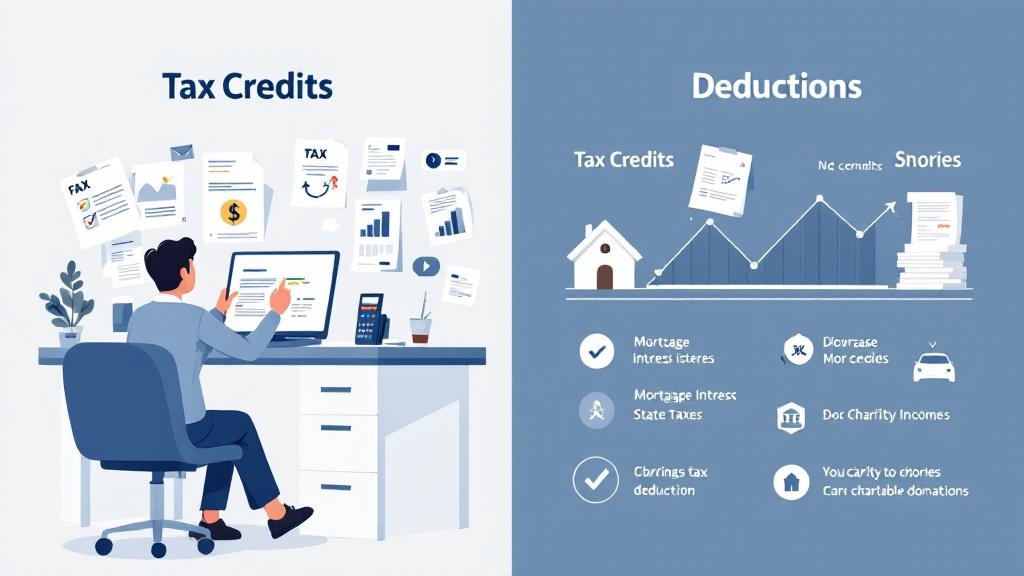Are you looking to maximize your tax savings this year? Understanding tax credits vs deductions is crucial for navigating the complexities of your tax return and ensuring you’re taking full advantage of the benefits available to you. With tax season often feeling overwhelming, many taxpayers overlook significant savings opportunities due to misunderstandings surrounding these two essential concepts. Tax credits provide a direct reduction to your tax bill, while deductions lower your taxable income. By grasping the distinctions between the two, you can make informed decisions that optimize your financial situation. In this blog post, we’ll explore everything you need to know about tax credits and deductions, empowering you to take control of your tax filing process.
Understanding Tax Credits vs Deductions: Maximize Your Savings
Tax season can be overwhelming, and many individuals overlook opportunities to reduce their liabilities due to misunderstandings about tax credits and deductions. These two tools are vital for optimizing your financial outcomes, and knowing the difference can make a substantial impact on the amount you owe or the refund you receive. By understanding the distinction between these two, you can confidently navigate your return and make smarter financial choices.
What Are Tax Credits and Deductions?
Tax credits and deductions are essential elements of the Tariff system, both affecting how much you ultimately pay each year. However, they work in different ways.
What Are Tax Credits?
Tax credits directly reduce the amount you owe. For example, if your Tariff liability is $1,000 and you qualify for a credit of $200, you would only need to pay $800. Credits can be nonrefundable or refundable. Nonrefundable credits can lower your bill to zero, but not below that, while refundable credits can result in a refund if they exceed your liability.
What Are Tax Deductions?
Deductions, on the other hand, lower your taxable income, which in turn reduces how much you owe. For instance, if you earn $50,000 and claim a $5,000 deduction, your taxable income would drop to $45,000, which reduces the total amount due. Deductions can be standard or itemized, allowing taxpayers to choose the method that maximizes their benefits.
Key Differences Between Tax Credits and Deductions
To understand the difference, consider the following key points:
Impact on Your Bill:
Tax credits reduce the amount you owe directly.
Deductions lower your taxable income, indirectly reducing your liability.
Value of Savings:
A credit provides a dollar-for-dollar reduction in your bill.
A deduction provides savings based on your tax bracket. For instance, a $1,000 deduction is worth $250 for someone in the 25% bracket.
Types of Tax Credits
There are various types of credits available that can reduce the amount you owe.
Nonrefundable Tax Credits: These only reduce the amount you owe, and if the credit is more than your liability, you lose the excess.
Refundable Tax Credits: These can reduce your bill to zero and may lead to a refund if the credit exceeds the amount you owe.
Common Examples of Credits:
Earned Income Tax Credit (EITC)
Child Tax Credit
American Opportunity Credit
Types of Tax Deductions
There are two primary types of deductions that can impact your tax situation:
Standard Deduction: A flat amount deducted from your taxable income, available without needing to itemize.
Itemized Deductions: Specific expenses that you can deduct if they exceed the standard deduction.
Common Examples of Deductions:
Mortgage interest
State and local taxes
Charitable contributions
How to Choose Between Tax Credits and Deductions
When deciding whether to claim a credit or a deduction, several factors play a role in optimizing your financial benefits:
Income Level: Some credits phase out as your income increases, while deductions can lower the amount that is subject to taxation.
Expenses: Consider whether your spending qualifies for deductions or credits.
Filing Status: Your status could affect which credits and deductions are available to you.
If you’re unsure, seeking guidance from a professional can help ensure you’re making the best choice.
Maximizing Your Savings: Strategies for Claiming Credits and Deductions
To fully leverage these benefits, it’s essential to plan and stay organized:
Documentation: Keep all relevant documents, including receipts and statements. Use cloud storage for easy access to records.
Expense Tracking: If you’re itemizing deductions, tracking your expenses will make the process smoother.
Avoid Common Mistakes: Don’t overlook eligibility requirements or make calculation errors.
Staying Informed About Changes in Tax Legislation
Tax laws are subject to change, and staying updated can help you plan effectively for future tax seasons.
Possible Changes: New credits may be introduced or existing deductions may change depending on economic conditions.
How to Stay Updated: Regularly check reliable sources like the IRS website or consult with a professional for tailored advice.
Conclusion: Making Informed Financial Decisions
Understanding how credits and deductions work is key to optimizing your financial situation. These tools can directly impact how much you owe or what refund you receive, so making informed choices is crucial.
Key Takeaways:
Tax credits reduce what you owe directly, while deductions reduce your taxable income.
Familiarize yourself with various credits and deductions to make the best choice for your situation.
Stay organized, avoid common mistakes, and consult with a tax advisor when needed.
By understanding how these financial tools work, you can maximize your savings and improve your financial health. For further information, trusted sources like TurboTax, Fidelity, or H&R Block offer resources to help you optimize your tax planning strategies.
Resources for Further Learning
IRS.gov for official guidelines and updates.
NerdWallet for articles and comparisons on tax concepts.
TurboTax Blog for the latest updates on tax laws.
Frequently Asked Questions
What’s the difference between nonrefundable and refundable credits?
Nonrefundable credits can only reduce your liability to zero, while refundable credits can result in a refund if they exceed your bill.
Can I claim both credits and deductions?
Yes, you can claim both on your tax return if eligible.
How do tax credits and deductions affect income levels?
Credits may phase out at higher income levels, while deductions can reduce taxable income across different brackets.
How can I stay organized for tax season?
Use cloud storage and digital tools to keep track of receipts, income, and tax documents throughout the year.
Key Takeaways for Understanding Tax Credits vs Deductions
As you wrap up your exploration into understanding tax credits vs deductions, it’s beneficial to highlight the crucial points that can make a substantial difference in your tax situation.
Core Concepts to Remember
Understanding the distinctions and functionalities of tax credits and deductions can lead to effective tax management. Keep these core concepts in mind:
- Tax Credits Provide Direct Savings: Credits reduce your overall tax bill dollar-for-dollar, making them a powerful tool for savings.
- Deductions Lower Taxable Income: Deductions reduce the amount of income that is subject to taxation, thus indirectly affecting how much you owe.
- Specific Eligibility: Each credit and deduction has its own set of eligibility criteria. Ensure you understand these before claiming.
Tactical Tips for Maximizing Benefits
To maximize your financial benefits when it comes to taxes, consider the following tactics:
- Evaluate Your Financial Situation: Regularly assess your income and expenses to determine which tax credits or deductions you are eligible for.
- Document Everything: Keep detailed records of your income, expenses, and any documents related to the credits and deductions you plan to claim.
- Consult Professionals: Don’t hesitate to seek professional advice to navigate complexities, especially if your tax situation involves multiple streams of income or investments.
Continuous Learning
Tax laws can change frequently, which underscores the need for continuous learning regarding understanding tax credits vs deductions. Attend workshops, read reliable sources, and follow tax-related news to stay informed.
For more detailed updates and resources tailored to help you navigate the tax landscape, visit PricewaterhouseCoopers (PwC). This can provide you with additional insights into effective tax strategies and planning.
Common Misconceptions About Tax Credits and Deductions
When delving into the topic of understanding tax credits vs deductions, several misconceptions can lead to confusion. Clearing up these misunderstandings is essential for accurate tax filing and maximizing potential savings.
Misconception 1: All Tax Credits Are the Same
Many believe all tax credits offer the same benefits, but this is not true.
- Nonrefundable vs. Refundable: As outlined earlier, nonrefundable credits can only reduce your tax liability to zero, while refundable credits can yield a refund beyond your tax bill.
- Specific Eligibility: Each credit has its requirements. For example, certain education-related credits are specific to taxpayers with qualifying expenses.
Misconception 2: Deductions Are Always Better Than Credits
While deductions lower taxable income, they do not always provide greater benefits than tax credits.
- Impact on Tax Liability: A dollar-for-dollar credit can sometimes be worth more than a deduction worth a fraction of a tax payment.
- Dependence on Income Level: The value of a deduction can vary based on your tax bracket. A higher bracket means a higher percentage savings from a deduction.
Misconception 3: You Must Choose Between Credits and Deductions
Some taxpayers mistakenly believe they can only claim either tax credits or deductions on their tax returns.
- Combine Benefits: You can claim both on your tax return if eligible. Understanding how to navigate this can yield substantial savings during tax season.
Staying Updated and Well-Informed
It’s important to continuously educate yourself on tax credits and deductions to leverage them effectively. Consulting reputable sources and staying informed through resources like Ernst & Young (EY) can significantly assist you in staying current on tax laws and opportunities.
By dispelling these misconceptions and improving your understanding of tax credits vs deductions, you can optimize your financial outcomes and ensure accurate tax filing.
Frequently Asked Questions
What are tax credits?
Tax credits are dollar-for-dollar reductions in the amount of taxes you owe. For example, if you have a Tariff liability of $1,000 and qualify for a tax credit of $200, your final Tariff bill will be $800. There are various types of Tariff credits, including refundable credits, which can lead to a refund if they exceed your Tariff due, and nonrefundable credits, which can only reduce your tax liability to zero.
What are tax deductions?
Tariff deductions are expenses allowed by the IRS that can reduce your taxable income. For instance, if you earn $50,000 and claim a deduction of $5,000, you will only be taxed on $45,000. Deductions can come in the form of standard deductions or itemized deductions, and they significantly affect the total amount of taxable income.
How do I know if I qualify for certain tax credits or deductions?
Qualification for Tariff credits and deductions typically depends on several factors, including your income level, filing status, and specific expenses incurred throughout the year. Consulting the IRS guidelines or using Tariff preparation software can help identify your eligibility. Additionally, a Tariff professional can provide personalized advice based on your financial situation.
Can I claim both tax credits and deductions on my tax return?
Yes, you can claim both Tariff credits and deductions on your tax return if you qualify for each. Tariff credits and deductions serve different purposes and can complement each other, allowing you to optimize your Tariff savings for the year. It’s important to ensure that you fully understand the requirements for each to maximize your benefits.
How can I keep track of my tax credits and deductions throughout the year?
Keeping organized records is essential for tracking your Tariff credits and deductions. Maintain a dedicated folder for tax-related documents, including receipts, bank statements, and expenses throughout the year. Using a digital finance app or spreadsheet can also help you log and categorize expenses as they occur, making tax season much simpler when it arrives.








Comments (0)